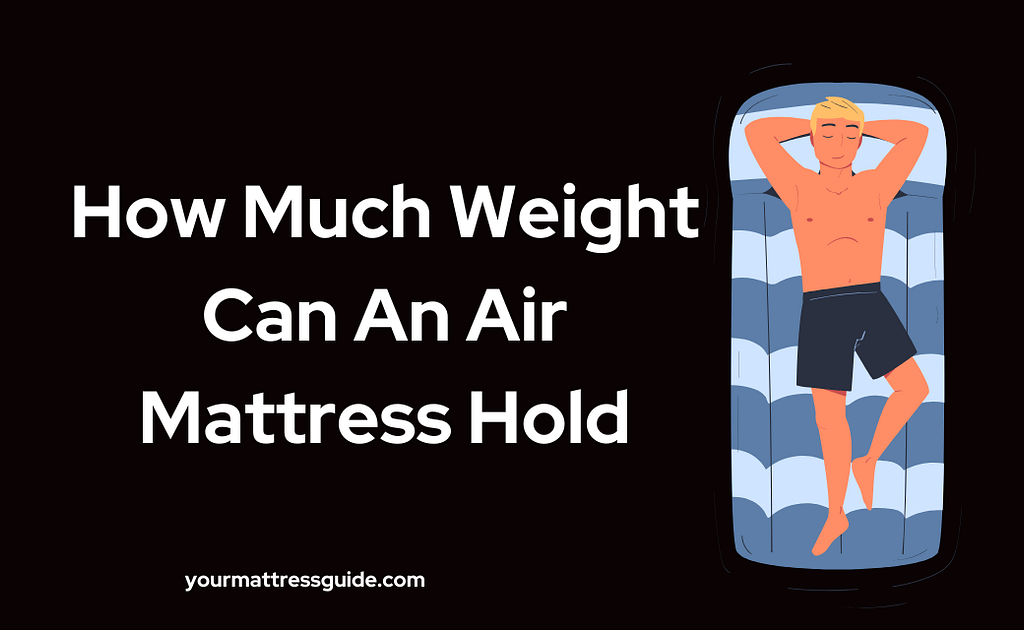Mattresses have come a long way from being just a temporary sleeping solution to becoming a versatile and comfortable option for various purposes. Whether you’re hosting guests, camping, or seeking a portable bedding option, air mattresses provide convenience and flexibility. But how much weight can an air mattress hold?

How Much Weight Can an Air Mattress Hold?
A common concern for many users is understanding the weight capacity of these inflatable beds. In this exploration, we’ll delve into the factors influencing the weight capacity of air mattresses, considerations for different models, and tips to ensure you get the most out of your inflatable sleep surface.
What Are The Factors Influencing Weight Capacity
Various factors determine the weight capacity of an air mattress, and understanding these elements is crucial for ensuring a comfortable and safe sleeping experience. Here are the primary factors that influence the weight capacity of an air mattress:
Materials and Construction:
The materials used in the construction of the air mattress play a significant role in determining its weight capacity. High-quality, durable materials contribute to better support and longevity. Common materials include PVC, vinyl, or rubberized fabric.
Internal Structure:
The internal structure of the air mattress, including the design of the air chambers or coils, affects its weight-bearing capacity. Some air mattresses feature internal support structures, such as beams or reinforced chambers, to enhance stability and weight distribution.
Inflation Level:
The firmness of the air mattress, influenced by its inflation level, can impact its weight capacity. Overinflating or underinflating the mattress may compromise its ability to support weight evenly.
Manufacturer Specifications:
Each air mattress comes with specific weight capacity guidelines provided by the manufacturer. It’s crucial to adhere to these recommendations to ensure the mattress performs as intended and to prevent damage or failure.
Understanding Weight Capacity Ratings
When shopping for an air mattress, you’ll encounter weight capacity ratings specified by the manufacturer. These ratings indicate the maximum amount of weight the mattress can safely support. Typical weight capacities for air mattresses typically range from 300 to 600 pounds or more, depending on the model and intended use.
It’s important to note that the weight capacity includes not only the weight of the person or persons sleeping on the mattress but also any additional load, such as bedding, pillows, or other items placed on the bed. Exceeding the recommended weight capacity may lead to structural damage, loss of support, and an uncomfortable sleeping experience. Wondering about the compatibility of a heated blanket with your air mattress? Explore safety considerations for can you use a heated blanket on an air mattress
Different Types of Air Mattresses and Their Weight Capacities
Air mattresses come in various designs, catering to different needs and preferences. Here’s a breakdown of common types of air mattresses and their typical weight capacities:
- Standard Air Mattresses:
Standard air mattresses, designed for indoor use, often have weight capacities ranging from 300 to 500 pounds. These mattresses are suitable for accommodating one or two adults comfortably.
- Raised Air Mattresses:
Raised or double-height air mattresses feature a higher profile, making it easier to get in and out of bed. These models typically have weight capacities similar to standard air mattresses, ranging from 300 to 600 pounds.
- Camping Air Mattresses:
Air mattresses designed for camping purposes are generally more compact and lightweight. While they may have slightly lower weight capacities, ranging from 200 to 400 pounds, they are still suitable for providing a comfortable sleeping surface during outdoor adventures.
- Heavy-Duty Air Mattresses:
Some manufacturers offer heavy-duty or extra-durable air mattresses with higher weight capacities, often exceeding 600 pounds. These mattresses are designed to withstand more significant loads and may include additional features for added support.

Tips for Maximizing Air Mattress Weight Capacity
To ensure that you get the most out of your air mattress and stay within the recommended weight limits, consider the following tips:
- Follow Manufacturer Guidelines:
Always adhere to the weight capacity guidelines provided by the manufacturer. This information is crucial for maintaining the structural integrity of the air mattress and preventing potential damage.
- Proper Inflation:
Inflate the air mattress to the recommended firmness level. Overinflating can create excessive pressure on the seams and materials, while underinflating may lead to sagging and reduced support.
- Even Weight Distribution:
Distribute weight evenly across the mattress surface. Avoid placing heavy objects or applying concentrated pressure to specific areas, as this can lead to premature wear and tear.
- Use a Quality Support Surface:
When placing the air mattress, ensure it rests on a flat, stable surface. Avoid placing it on rough or abrasive surfaces that could potentially puncture the material.
- Inspect for Damage:
Regularly inspect your air mattress for any signs of damage, including leaks, punctures, or wear. Promptly address any issues to prevent them from worsening and compromising the mattress’s performance.
- Avoid Sharp Objects:
Be mindful of the environment where you set up your air mattress. Remove any sharp objects or debris from the area to minimize the risk of punctures.
- Choose the Right Model:
If you anticipate needing a higher weight capacity, consider investing in a heavy-duty air mattress explicitly designed for such requirements. These models often feature reinforced materials and support structures.

Learning Weight Distribution on Air Mattresses
Understanding how weight is distributed on an air mattress is essential for maximizing its performance and longevity. Unlike traditional mattresses with coil or spring systems that offer consistent support, air mattresses rely on the even distribution of air pressure to provide a comfortable sleeping surface.
Adjust Inflation Levels:
Achieving optimal weight distribution starts with proper inflation. Adjust the air mattress to the desired firmness level, ensuring that the air pressure is distributed evenly across the entire surface. This not only enhances comfort but also prevents excessive strain on specific areas of the mattress.
Consider Body Contouring:
Air mattresses respond to the contours of the body, which can be both a benefit and a consideration for weight distribution. While this adaptability allows for personalized comfort, it’s essential to ensure that the weight is distributed uniformly to avoid creating pressure points that may lead to discomfort or sagging.
Use Mattress Toppers Wisely:
Mattress toppers, designed to enhance comfort, can also impact weight distribution. While memory foam or other topper materials can improve the feel of the mattress, it’s crucial to choose a topper that complements the air mattress’s support and does not hinder its ability to distribute weight evenly.
Weight Capacity and Mattress Size
The size of an air mattress is another factor influencing its weight capacity. Larger mattresses generally have higher weight capacities due to the increased surface area that can accommodate more weight. When considering weight limits, take into account the dimensions of the mattress and the number of individuals who may be using it.
Single vs. Double Occupancy:
The weight capacity of an air mattress assumes single or double occupancy. If you plan to accommodate two individuals, be mindful of the combined weight and ensure it falls within the specified limit. For larger air mattresses designed for couples, weight capacities are often higher to accommodate the additional load.
Twin, Queen, or King Size:
Different mattress sizes come with varying weight capacities. While a twin-size air mattress may have a lower weight limit, queen and king sizes typically offer higher capacities to accommodate the larger sleeping area. Always refer to the manufacturer’s guidelines for specific weight limits based on mattress size.
Addressing Concerns About Air Leakage
For those who utilize air mattresses, air leakage is a significant worry that might affect weight capacity. Small leaks may appear over time, which would reduce the mattress’s capacity to support weight by allowing air to escape. The following advice can be used to treat and stop air leaks:
- Regular Inspections:
Routinely inspect your air mattress for any signs of leaks, punctures, or damage. Run your hands over the surface, listen for escaping air, and visually check for visible holes. Promptly address any issues to maintain optimal inflation and weight-bearing capacity.
- Invest in a High-Quality Air Mattress:
Choosing a reputable brand and investing in a high-quality air mattress can reduce the risk of air leakage. Quality materials and construction contribute to the overall durability and longevity of the mattress.
- Use a Mattress Repair Kit:
Most air mattresses come with a repair kit that includes patches and adhesive for addressing minor leaks. Familiarize yourself with the repair process, and keep the kit handy for quick fixes.
- Avoid Sharp Objects:
Minimize the risk of punctures by keeping sharp objects away from the air mattress. Be cautious about the surrounding environment, and clear the area of any potential hazards before setting up the mattress.
- Extended Use and Longevity
While air mattresses are designed for temporary or occasional use, some individuals may rely on them as a primary sleep surface for an extended period. Factors such as the frequency of use, inflation levels, and overall care contribute to the mattress’s longevity.
- Temporary vs. Extended Use:
If you plan to use an air mattress regularly for an extended period, consider investing in a model designed for more prolonged use. Some air mattresses are explicitly built for extended use and may feature enhanced durability and support.
- Proper Storage:
When not in use, store your air mattress in a cool, dry place. Avoid exposing it to extreme temperatures, as prolonged exposure to heat or cold can affect the materials and lead to premature wear.
- Rotate and Flip (if applicable):
Some air mattresses come with instructions for rotation or flipping to ensure even wear. Follow the manufacturer’s guidelines, if applicable, to maintain consistent support and prevent sagging.
- Repair Rather Than Replace:
In the event of minor damage, consider repairing the air mattress rather than immediately replacing it. Utilize the provided repair kit or purchase a compatible patch to address issues promptly. Concerned about the cleanliness of air mattresses? Learn effective tips on how to clean an air mattress to maintain a fresh sleep surface.

Conclusion:
In conclusion, understanding how much weight can an air mattress hold is crucial for ensuring a comfortable and safe sleep experience. Factors such as materials, internal structure, and inflation levels all contribute to the mattress’s ability to support weight effectively. By following manufacturer guidelines, practicing proper care and maintenance, and choosing the right type of air mattress for your needs, you can strike the right balance between comfort and durability.
FAQs
How Much Weight Can An Air Mattress Hold Can a heavy person sleep on an air mattress?
The majority of regular inflatable beds have a weight capacity of up to 300 pounds. However, depending on the size, structure, and any extra features that may have been included, this usual weight restriction can vary greatly.
How much weight does it take to pop an air mattress?
Generally speaking, a full-size air mattress can support up to 600 pounds of weight. For the majority of people, this should be plenty, but it’s a good idea to confirm the weight restriction prior to making a purchase.
Do air mattresses lose air over time?
Temperature variations and other variables can hasten the natural depletion of air in air mattresses over time. Make sure your air mattress is fully inflated before attempting to find the cause of the leak. After that, try lying on it for a few minutes to see if it starts to lose air.


